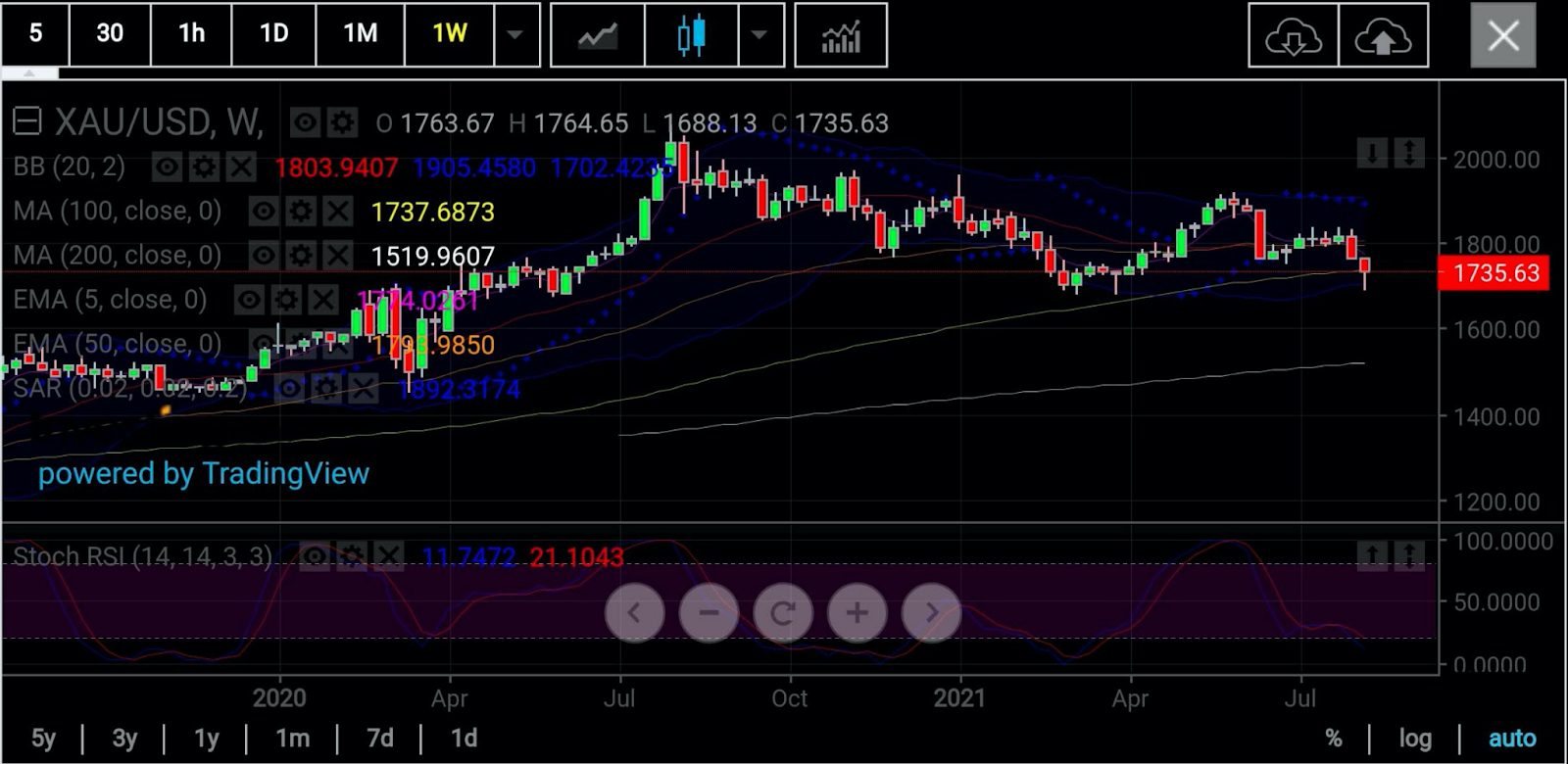Has gold dropped as much as it could pre-Jackson Hole?
Some charts indicate that possibility, and the more than 24 hours that have passed since the Asian flash crash—with no repeat—have helped gold longs rebuild confidence as they try to make their way back to mid $1,700 levels.
Yet, the calm after a storm can sometimes be deceiving—especially if another hurricane is headed your way. And that should be the concern of anyone buying the dips in gold.
If the objective is to clear out with tight, narrow gains, then fine. But, if it is to recapture mid-$1,800 levels with loose stop losses along the way, then the window for return could be considerably longer, and the risk considerably higher.
Whatever the case, with more talk of a Federal Reserve stimulus taper at any time of the day now, compared to a Fed stay on asset buying and rates, gold at best could be soft and range-bound in the countdown to the central bank’s Aug. 26-28 Jackson Hole, Wyoming symposium on monetary policy.

All charts courtesy of by SK Dixit Charting
Chartist Ross J Burland said in a blog post on FX Street on Monday:
“From a daily perspective, the price has corrected as hard as it fell and this gives rise to come, meanwhile, to-ing and fro-ing in the low to the middle ground of the $1,700s with a focus on the 38.5% Fibonacci and 50% mean reversion areas.”
Thus, the spot price of gold has overshot technical supportive structures on a weekly basis and cleared the way for “a sustained move in on the higher third of the $1,600s,” Burland said.

Gold was relatively steady in Monday’s morning trade in Asia before suddenly plunging almost $75 from Friday’s close of $1,762.69 to $1,688.13 over a matter of minutes. Since then, it has firmly held above $1,700, mostly boxed in a $1,730-$1,740 range.
Fundamentally, gold’s return to $1,600—or even lower—cannot be discounted as we get nearer to Jackson Hole amid the incessant invoking of taper and rate hike language by Fed officials in their daily speaking engagements.
Atlanta Fed President Raphael Bostic’s comments, particularly, stood out Monday for its pointed urgency in pushing for a tightening.
The Fed could begin tapering between October and December the $120 billion it has been plonking monthly into bonds and mortgage-backed securities to support the COVID-restrained economy, Bostic told a live-streamed event. This is especially so if jobs growth over the next couple of months can match July’s near one-million, the Atlanta Fed chief added.
If such a wait-and-see approach is indicated and adopted at Jackson Hole, then gold prices may not go into a free-fall, but rather decline based on the strength of the employment and economic data at hand.
Even between now and the next couple of weeks, the yellow metal may stay range-bound rather than plunge to $1,600 levels.
Burland thinks similarly, saying:
“It may take several weeks for the bears to build up enough of a support base in order to get there again from this juncture.”
Sunil Kumar Dixit, who heads Kolkata, India-based SK Dixit Charting, says so long as gold holds above the 100-week Simple Moving Average of $1,737, recovery from the lows will likely take prices higher, from $1,758 through $,1770-$1790-$1803 and $1,815.
“Though the possibility of a horizontal support base appears weak, some bounce back is likely,” Dixit said. “Bulls are likely to wait for gold to take on the $1,832 barrier for further upside.”
But there was just as much risk of the market going the other way, given the dynamics of the potential Fed tightening, Dixit cautioned.
“A weekly closing below the 100-day Simple Moving Average of $1,737 would expose the metal to the March low of $1,676 and extend losses to $1,585,” he said.
This was because on gold’s monthly chart, there seemed to be an alignment to the June 2020 low of $1,670, the March 2021 low of $1,676 and the latest low of $1,684, Dixit added.

Others believe Fed noise, along with the ramping Dollar Index and the relative strength of the 10-year Treasury note, will set the agenda for gold’s downside.
Dhwani Mehta, another chartist who blogs on FX Street, said the so-called Technical Confluences Detector she tracks shows gold is challenging critical resistance at $1737.
“On rejection at the latter, sellers could return, looking for a target at the previous high at $1,733. If the downside pressure intensifies, then a test of the Fibonacci 161.8% one-month at $1,725 will be inevitable. Further south, the Fibonacci 38.2% one-day at $1,718 will be threatened.”
Disclaimer: Barani Krishnan uses a range of views outside his own to bring diversity to his analysis of any market. For neutrality, he sometimes presents contrarian views and market variables. He does not hold a position in the commodities and securities he writes about.
